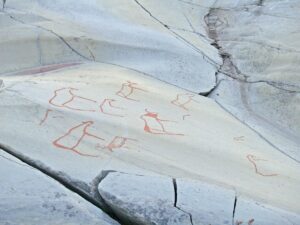Introduction
What makes us human? This fundamental, philosophical question drives our motivation to understand past human behaviour within diverse fields from archaeology and palaeoanthropology to biology, cognitive science and beyond. Understanding the processes of human evolution – particularly when, why, and how certain behaviours emerged in our most ancient ancestors – undoubtedly holds some part of the answer to this question. Over the past decades – and indeed, centuries – of research, there have been a breadth of attempts to provide answers that centre on identifying the capabilities that set us apart from the rest of the mammalian world. Responses have varied from quotidian behaviours, such as tool making or fire production, to markers of creativity such as art, personal ornamentation or even funerary practices.
The implicit assumption lurking under the surface of these attempts to answer this question is that there is a “golden threshold” that makes use unique from other species, a core feature of our character that makes our kin exceptional. These discussions have intrinsically associated such “golden thresholds” to cognitive capabilities, arguing that the emergence of such behaviours in the archaeological record must be associated with significant changes in the organisation or development of the human brain. The so-called “Upper Palaeolithic revolution” is a zeitgeist of this mode of thinking. Fundamentally rooted in European-centric approaches, this idea proposed that a cognitive change must have happened once Homo sapiens reached Europe that stimulated the “explosion” of material and visual culture. This mode of thinking exhibits evident issues, as it surprisingly omits crucial aspects such as taphonomy, preservation, and research biases from the discussions.
These discussions have intrinsically associated such “golden thresholds” to cognitive capabilities, arguing that the emergence of such behaviours in the archaeological record must be associated with significant changes in the organisation or development of the human brain.
In more recent years, this human exceptionalism perspective has been challenged. Neanderthals, once perceived to be a brutish “missing-link” between humans and apes, have been understood as a species with equally intricate cultural behaviours, producing complex composite tool technologies, synthetic adhesives, personal ornamentation and even parietal art. This presented a problem – if these behaviours have been linked to the exceptionalism of our brainy species, how could it be that they are present in another? Immediate responses to some of the earlier evidence outright dismissed it, claiming issues with attributing Neanderthal authorship. Maybe H. sapiens were just present in areas earlier than we thought? Or maybe those pesky Neanderthals stole objects or ideas from their much more intelligent cousins? This “Neanderthal problem” appears to have now been quietly settled, with an implicit agreement that Neanderthals may have had something called “cognitive complexity” but still lacked that special something (i.e., grave goods, painting on cave walls, drawing animals). This neat solution persists, with any new evidence of the rich socio-cultural behaviours of Neanderthals used only to support the assertion that they were “cognitively complex” – whatever that may mean.
So, when the news recently broke about tentative evidence emerging from the Rising Star cave system (South Africa) that a small, distantly-related hominin species, Homo naledi, may have engaged in the same behaviours previously thought to be unique to humans, it stimulated lively – and sceptical – reactions. Although there is a clear need to robustly evaluate this evidence, it also encourages a reassessment of how we conceptualise “complex” behaviours in both our own species, and other hominins. Why do we perceive certain behaviours as “special”? Is it appropriate to assume a direct association between certain behaviours and a “complex” cognition? Can we move beyond golden thresholds, to a more nuanced understanding of what this type of evidence is telling us?
Although there is a clear need to robustly evaluate this evidence, it also encourages a reassessment of how we conceptualise “complex” behaviours in both our own species, and other hominins.
New Evidence at Rising Star Cave?
The preprints released by the Rising Star research team outline possible evidence for rock art produced in the cave and an intentional burial of a H. naledi individual, both attributed to a date of 241,000 to 335,000 BP. If robustly demonstrated to be convincing evidence, these findings would represent the oldest examples of both art and intentional burial in the archaeological record. However, once the preprints have been peer reviewed, many researchers have expressed their concern with these claims. For the possible rock art engravings, several archaeologists have argued that the lack of high-resolution and macro photographs in the preprints make it difficult for other researchers to assess whether the marks are anthropogenic or natural. The marks identified as engraved lines look similar in form to natural fractures that occur in dolomite – the rock type that forms the Rising Star cave system. The percussive marks are somewhat more convincing as intentionally produced, but without robust dating that can securely attribute the “art” to the age claimed in the preprint, it is difficult to determine whether these were produced by H. naledi.
Furthermore, regardless of their possible validation as solid evidence for understanding the emergence of “symbolic behaviors”, such as art or funerary practices – discussed in the third preprint – these findings also encourage a reconsideration in the way we approach and understand these behaviors in human evolution. Particularly over the past decade, there has been a flurry of new evidence questioning the exceptionalism of so-called “modern behaviors,” incidentally challenging some of the implicit assumptions within human evolutionary research about the implications of this type of evidence. The Rising Cave findings, along with their validation, also require a reassessment of how we conceptualize so-called “symbolic” behaviors.
The Rising Cave findings, along with their validation, also require a reassessment of how we conceptualize so-called “symbolic” behaviors.
Do Marks Always Have Meaning?
One of the fundamental assumptions within Paleolithic art research, and indeed implicit in the discussion surrounding possible evidence of markings on the Rising Star, is that the intentionally produced abstract markings must have had meaning to their creators. This conceptual leap seems innocuous, but it contains some significant assumptions, predominantly that the first marks of this type are symbols that contained meaning beyond their aesthetic form.
Hodgson has presented an alternative perspective in his research concerning the early abstract marks produced by H. sapiens at Blombos cave. His Neurovisual Resonance Theory (NRT) proposes that since the visual system is fundamentally primed to rapidly identify contours, intersecting lines, and edges – in order to process visual stimuli in the world – then this kind of stimuli would resonate with the visual system and induce an aesthetic pleasure response. For the Blombos material, he argues that the incidental production of such marks, i.e., through the scraping and grinding of ochre, would have stimulated this aesthetic pleasure response, and subsequently the intentional production of geometric marks. The marks themselves do not contain meaning, but rather represent a creative exploration of the ability to produce intentional markings on materials – motivated by pleasure responses that derive from fundamental mechanisms in the visual system.
The marks themselves do not contain meaning, but rather represent a creative exploration of the ability to produce intentional markings on materials – motivated by pleasure responses that derive from fundamental mechanisms in the visual system.
This perspective has the potential to challenge some assumptions that the possible engravings in Rising Star represent “meaning-making behaviour”. Since our closest extant ancestors, chimpanzees and bonobos, process visual information in the same way, we can perhaps assume H. naledi would have had a similar visual system that had preference for visual stimuli with edges, contours, and intersecting lines. The production of marks that contain these kinds of visual information by H. naledi may, therefore, represent an aesthetic-pleasure derived response – perhaps emerging from accidental instances of producing such marks that gradually developed into the intentional, playful production of intentional geometric marks. They need not contain meaning or have been used as symbols; rather, it may have simply been the production of the marks themselves that was enjoyable. Indeed, chimpanzees, when presented with painting materials, seem to derive pleasure from the ability to make intentional marks, although spontaneous marking behavior has not yet been recorded as such in nonhuman primates. Thus, whilst it is entirely probable that H. naledi were capable of producing such marks, this does not necessarily indicate the intentional production of symbols (i.e., a motif that holds an abstract meaning unrelated to its form).
Thus, whilst it is entirely probable that H. naledi were capable of producing such marks, this does not necessarily indicate the intentional production of symbols (i.e., a motif that holds an abstract meaning unrelated to its form).
As noted in the third preprint released by the Rising Star team, there is no need to theoretically couple mark-making behaviour with an increase in hominin brain size – yet equally, and contrary to their discussions, there is also no need to couple mark-making behaviour and notions of cognitive complexity.
Need to Move Beyond Notions of “Cognitive Complexity”
The tentative evidence from Rising Star encourages a critical re-evaluation of the way we conceptualise evidence of particular “complex” behaviours in the archaeological record. The tendency to leap to conclusions about certain behaviours evidencing cognitive complexity, and cognitive complexity being defined as the ability to do certain behaviours, constrains our understanding of different hominin species within a circular, one-dimensional argument. Furthermore, the term “cognitive complexity” is often poorly defined and therefore inherently useless: a cognitive scientist, for example, would raise a critical eyebrow at the way archaeologists and paleoanthropologists assume that there is “complex cognition” that it can be usefully employed in discussions of hominin capabilities.
So where does that leave us, and what does this mean for understanding H. naledi? Fundamentally, this new research is a clear reminder that we shouldn’t be seeking out evidence that “proves” cognitive or cultural complexity. By continuously reinforcing ideas of golden barriers that demonstrate the “complexity” of a species, we overlook the potential to develop more nuanced insights into different hominins that appreciate them in their own right – rather than compare them to our own species. H. naledi may not have intentionally produced symbols or buried their dead, but what did they do? Other recent evidence from Rising Star suggests H. naledi may have intentionally used fire within the cave and this evidence appears more compelling than that presented in the most recent preprints. Understanding this behaviour in more depth, how and why H. naledi produced fire, has the potential to shed new light on this species – for example, their subsistence behaviours (did they cook food?) or even survival strategies (did fire ward off predators?). These kinds of nuanced questions are more valuable for understanding our distant hominin cousins, than those that unfairly compare them to our own perceived “exceptionalism.”
These kinds of nuanced questions are more valuable for understanding our distant hominin cousins, than those that unfairly compare them to our own perceived “exceptionalism.”
Izzy Wisher is an archaeologist, specialising in interdisciplinary approaches to Palaeolithic art. She is currently a postdoctoral researcher at Aarhus University (Denmark), working alongside cognitive scientists on the ERC project eSYMb: The Early Evolution of Symbolic Behaviour. She completed her PhD in 2022 at Durham University (UK), where she used virtual reality and methods from psychology to understand how pareidolia – the phenomenon of seeing forms in random patterns, like faces in clouds – influenced the production of Upper Palaeolithic cave art in northern Spain.


